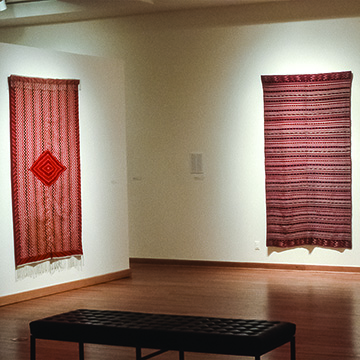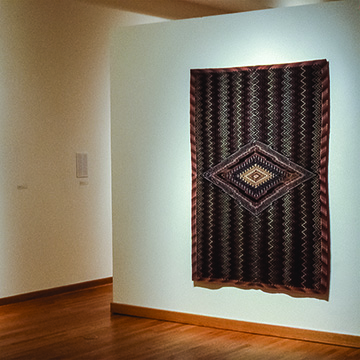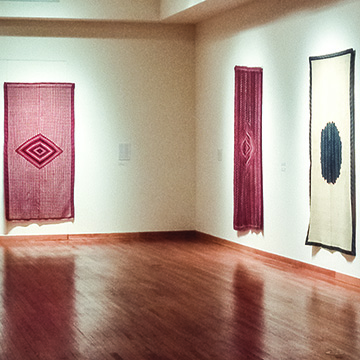The Saltillo Sarape
Saltillo sarapes – the prestigious Mexican wearing blankets – comprise one of the most remarkable weaving traditions in the history of the New World. The JCCC Gallery of Art will present an exhibition of sarapes of the 18th and 19th centuries, drawn from private collections. A gallery walk and lecture by collector Mark Winter will be held in conjunction with the opening.
Named for the town of Saltillo in northern Mexico where textiles were traded, Saltillo sarapes of the “classic” period (ca. 1750-1825) and “late classic” period (1800-1860) are among the most visually and technically superb examples of the weaver’s art. The origins of the Saltillo sarape, specifically information about the women weavers or their weaving conditions, design sources and its development into a highly sophisticated art form, remain obscure in Spanish Colonial history. Existing evidence indicates that, like so much of Mexican culture, Saltillo sarapes are the result of centuries of blending Native American and European traditions.
Saltillo sarapes generally have three principal design elements: 1) a large central diamond or circular medallion set against 2) a background field of often contrasting design and 3) a border or frame (frequently similar in design to the central medallion) that encloses the sarape. Intricate patterns were created with brilliantly colored, naturally dyed wool, woven on a hand-plied cotton foundation. Many sarapes were woven in two identical sections and joined together with an opening for the head. Worn as ponchos, Saltillo sarapes were ideally suited for horseback wear. In the 18th and early 19th centuries, the Saltillo sarape served as a visible emblem of wealth and position for Mexican landowners.
Saltillo sarapes were widely traded throughout Mexico and made lasting impressions on a number of other textile traditions. The Saltillo style was incorporated into sarapes woven throughout Mexico, Central America, and into the present-day southwestern United States. It is especially apparent in the wearing blankets from the Rio Grande Valley in Northern New Mexico and southern Colorado. Examples of the better-known Navajo weaving tradition, most notably the Sarape and Eye-dazzler styles, also reflect the influence of Saltillo sarapes.
During a surge of nationalism in the late 19th and early 20th centuries, the sarape became Mexico’s national symbol and was worn by all classes. The increased popularity led to mass production which eventually caused the quality of weaving to decline, never again to equal the technical and artistic achievement of the classic Saltillo sarape.
The gallery guide includes an essay excerpted and edited from The Saltillo Sarape by Paula Marie Juelke, Santa Barbara Museum of Art, 1978, courtesy New World Arts and Mark Winter.
A leading collector and dealer in Native American textiles, Mark Winter began studying and acquiring Saltillo sarapes over 20 years ago. His research led to extensive travel, as he sought information on sarapes from private and public collections throughout the United States and Mexico. Winter has participated in numerous museum exhibitions, both as a lender and consultant. Most recently, he served as guest curator of Pattern of Prestige: The Development and Influence of the Saltillo Sarape for the Museum of American Folk Art, New York, and The Textile Museum, Washington, D.C. Winter and his family reside in Santa Fe, New Mexico.





